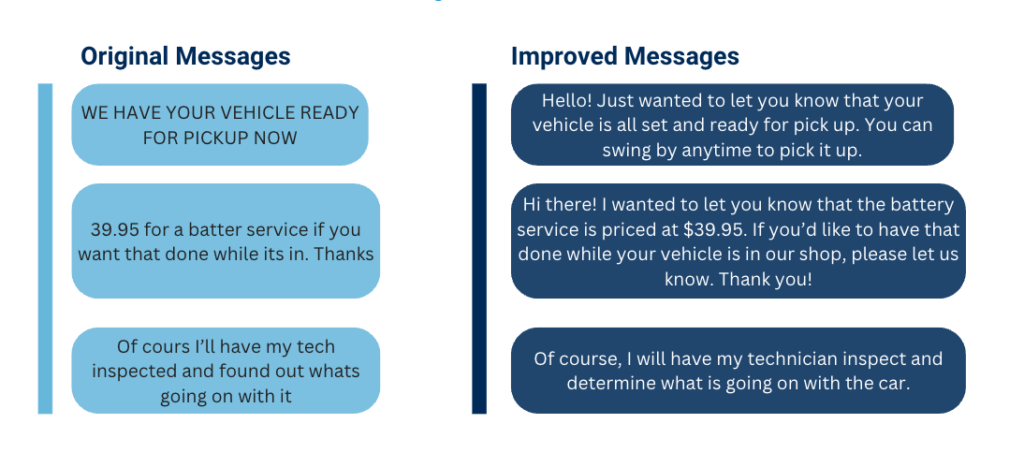The word is out: Using video and texting in your service department is a consistent, reliable driver of approvals on recommended work and the increased revenue that comes with it. Oh, and customers love it.
With the majority of franchise dealers in the US now leveraging inspection videos and advisor-to-customer texting to create a better, more efficient mode of communication with their customers, many quickly find themselves in phase two: maximizing tech utilization, view rates, and video/texting quality.
This is where dealers—who have switched platforms at least once—have gained a key understanding about video/texting software. It’s not all created equally.
One key differentiator to be aware of is “end-to-end” solutions versus dedicated video and texting technologies. With an overabundance of technology services being a shared pain point for many dealers, choosing a video partner that has an all-in-one scheduler, lane check-in, service video, etc., seems to make intuitive sense. Why work with multiple technologies if you can get it all in one place, right?
Not so fast.
This common misconception has led many dealerships down a slippery slope of committing to inferior video and texting technology through software consolidation. This technology is far too important a component of your service process and customer experience to risk underperforming for your service department—especially because it’s the key factor in approvals and CSI scores. So, what does this underperformance look like, and what does it mean for your business? Let’s break it down.
Poor technician utilization
When speaking with dealers who use some of the more common end-to-end solutions on the market, the description we hear most often is “clunky.” This typically means that the company who built the product is trying to play in multiple areas, with video and texting often being “tack-on” solutions. If you ask CDK or Reynolds, both of whom started building their own video solution before opting to partner with TruVideo instead, they’ll tell you that video/texting is far from an easy solution to build successfully and operate at the level that quality dealers (and their customers) expect.
This factor often negatively impacts technician adaptation and utilization. When technology doesn’t work seamlessly, your techs will opt out early. As a result, your video/texting strategy will only achieve a fraction of the original intended outcome—at best. Without consistent tech utilization (and bolstered by the increase in dollars in their paychecks from video-driven approvals), video will never do what its been proven to do when executed optimally, which is to drive tens of thousands of dollars in additional revenue each month through approvals, all while propelling your CSI scores even higher.
Low view rates
After talking to thousands of dealers, we’re certain that this is the greatest unknown difference between TruVideo and other video platforms out there. When dealers initially implement video into their service department, it can be seen as a checked box. But, as we hear consistently from our dealers coming from other platforms, there is a massive difference between just “doing video” and executing on a high-quality, high-performing video and texting strategy that you’ve embedded in your service department.
One important metric that often gets overlooked is video view rate – both relative and absolute. Your relative view rate is the percentage of videos sent to your customers that were actually viewed. Your absolute view rate assesses what percentage of repair orders had a video viewed by a customer, weighed against the total number of customer-facing ROs that should have included a video, whether that video was ever taken and sent or not. Absolute view rate is a key metric because it factors in both utilization/send rates and relative view rates on sent videos, and ultimately becomes your multiplier of the average lift in dollars-per-RO that comes from video views. On average, dealers using TruVideo see a 34% lift in RO dollars whenever a video is viewed. And, as dealers and OEMs have started to learn, both ends of that equation vary largely based on both whom you’ve partnered with and how they train, onboard and set you up for success.
So, what should these numbers look like? At TruVideo, we consistently see our relative view rates hover around 80%. Paired with our proactive and committed approach to training, onboarding, and long-term partnership, this typically drives absolute view rates well over 50% for our dealers. By comparison, many of the other popular video/texting platforms struggle to achieve even a 50% relative view rate. As for helping drive consistent tech utilization, consider this: Would you rather trust a partner whose sole focus is video execution, or a software partner who tacked on a video solution as a means to sell you one more product?
Poor video (and texting) quality
So, now your technicians are taking and sending videos to customers and your advisors are exchanging texts with them. Great. But, what type of customer experiences are those videos and texts driving for your customers? Like many things, the devil is in the details.
For starters, your videos should always be taken and sent in landscape mode. We all have smartphones, and we all know landscape is universally preferred. Yet, several solutions require techs to take videos in portrait mode. In many of those cases, technicians constantly want to turn their camera sideways which creates a dizzying experience for their customers in the process.
Background noise is another issue. Service bays are inherently noisy, so even if your technician records a top-tier video, air guns and drills can often become a barrier to the clarity you’re trying to provide. More solutions are offering noise canceling technology but traditional noise canceling software also drowns out the voice of the technician, distorting what is meant to be clear, informative communication. Because of this, TruVideo employed an AI-driven noise canceling experience, which actually trains to the frequencies of the technician’s voice and digitally minimizes any other frequencies behind the scenes: power tools, loud music, even other voices in the background. The result is that your techs always sound like they are speaking directly to the customer in a clear, quiet space.
Of course, what actually happens in the video matters too.
This depends on your video partner’s level of expertise on what constitutes a great, approval-driving inspection video, paired with their willingness to train and reinforce proven video best practices. For example, we run multiple training sessions to fully train your techs, advisors, and managers. Then we put you through our 90-day onboarding process, which initially focuses on driving utilization and then shifts into quality assessment and optimization. We even watch your technicians’ videos and provide video scorecards grading each technician on the results-driving components of your videos.
Having a proactive partner that is an expert in video execution and takes steps to help your team optimize their results is a huge difference-maker in successful implementation.
As for texting, it’s an easy argument to settle on the basis of “we do it” versus “we do it at a consistently high level for our customers.” We’ve all texted with someone who has terrible text etiquette, i.e., all caps, poor grammar sentence fragments, and/or a questionable-at-best tone. Now, picture each of your advisors texting with your customers every day. How many are A+ text communicators? Or, inversely, how many are committing any one or combination of these common text sins with your all-important service customers? It only takes one sub-par text to send a customer interaction into a tailspin. We’ve seen it first hand:
Your advisors need – and deserve – help in this department. And your customers deserve professional communication when trusting their car to be serviced at your dealership.
Driven by over 30 million service interactions that have taken place on TruVideo, we trained our artificial intelligence to both prompt relevant responses for your advisors on every inbound text from a customer, as well as professionalize every outbound text message when your advisor hits ‘Send’:
Elite service departments aim to create a consistent, high-quality service experience based around transparency and effective communication. We’ve built our platform to do exactly that. Our easy-to-use app for technicians helps maximize utilization, maximize view rates through deliverability and by adhering to best practices based on customer behavior, and optimizing the quality of video and text communication through dedicated training/onboarding and AI-powered features. TruVideo has taken every step to make a top-tier video-and-texting-driven strategy that drives revenue, improves CSI scores, and makes efficiency in your service department a very “tru” reality.
Think TruVideo is the right fit?
Let’s chat! Book a demo today.





